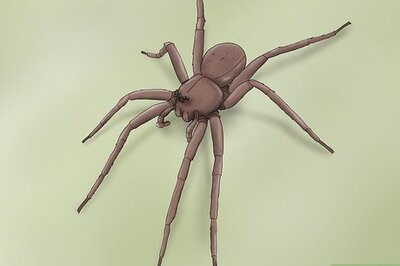
views
Ottawa: A talking robot assembled from household odds and ends is hitchhiking thousands of kilometres across Canada this summer as part of a social experiment to see if those of its kind can trust humans.
Society is "usually concerned with whether we can trust robots," Frauke Zeller, co-creator of the "hitchBOT," told AFP.
Hollywood movies like The Terminator and The Matrix often depict machines as enemies of mankind, according to the assistant professor at Toronto's Ryerson University.
But, she noted, quite the opposite is true of hitchBOT.
"This project turns our fear of technology on its head and asks, 'Can robots trust humans?'" Zeller said.
"Our aim is to further discussion in society about our relationship with technology and robots, and notions of safety and trust."
Zeller and fellow professor David Smith of McMaster University, along with a team of specialists, designed hitchBOT to be fully dependent on people.
"It cannot achieve its task of hitchhiking across Canada without the help of people, because it cannot move by itself," she said.
And hitchBOT certainly has what it takes to charm its way into people's hearts.
It can strike up a conversation and can answer trivia questions by consulting information using its built-in computers.
And it will even tell you when it's tired and in need of recharging from your car's cigarette lighter.
HitchBot has what has been described by Canadian media as a "yard-sale aesthetic," built for about $1,000 from parts found in a typical Canadian home or hardware store.
It has an LED-lit smiley face wrapped in a transparent cake saver set atop a plastic beer pail wrapped in a solar panel, with swimming pool noodles for limbs.
Its feet are rubber boots and it wears yellow latex gloves - including one with its thumb extended to show it wants to catch a ride.
The automaton's design couldn't be too heavy because it had to be manually lifted into a car.
The robot also had to be small enough to fit into the backseat of a car but still have enough heft so it would not be blown over by a gust of wind while hitchhiking on the side of the road.
And it had to be resistant to chilly temperatures common during Canadian late summer nights.
"It had to be sturdy but also appealing to people," Zeller said.
"We wanted people to feel like, 'Yeah, I should stop to help that robot.'"
And that's exactly what's been happening.
It began its trip on July 27 in Canada's Atlantic port city of Halifax, after being picked up by an elderly couple in a camper van.
They handed it off after a night in the Canadian outback to three young men from Quebec province.
HitchBot then zipped through eastern Canada to Toronto for a brief check-in with its creators before hitting the road again. It is ultimately headed for the country's westernmost city of Victoria - more than 6,000 kilometres from its starting point.
Rooting for hitchBOT
The trip is being documented on social media (www.hitchBOT.me), allowing people around the world to connect with the robot.
Less than 24 hours after it began its journey, it had already snapped up 12,000 followers on Twitter, including one fan who posted a photo of a cardboard box look-alike.
By Friday, the number of Twitter followers was nearly 20,000.
"Everyone is rooting for it," Zeller said.
"It's an interesting phenomenon - people are developing attachments to the robot, including many who (will) never meet hitchBOT, but are following it on social media."
Once its travels are over, researchers will analyse comments posted on Twitter and Facebook to see what they can surmise about the public's attitudes concerning robot-human interactions.
With growing use of mechanical humanoids in space, manufacturing and everyday life, "it's becoming more important to explore our relationship with robots -- especially if they come into our households," Zeller said.
Particularly interesting, she added, is the question of whether robots will be seen as disposable as they age and break down.
"What do we do when they will need to be repaired?" Zeller said, suggesting that some people may become attached to the little humanoids and will "keep and cherish" them.
"Do we repair them, or will they become just another convenient item that we can throw away?" she asked.
"We have to study all of that to ensure it works out right."
####




















Comments
0 comment